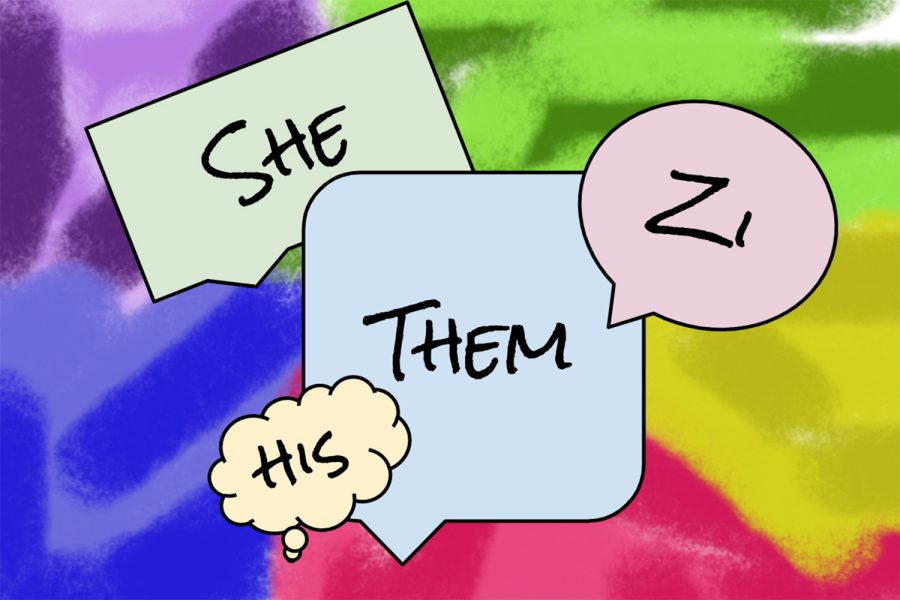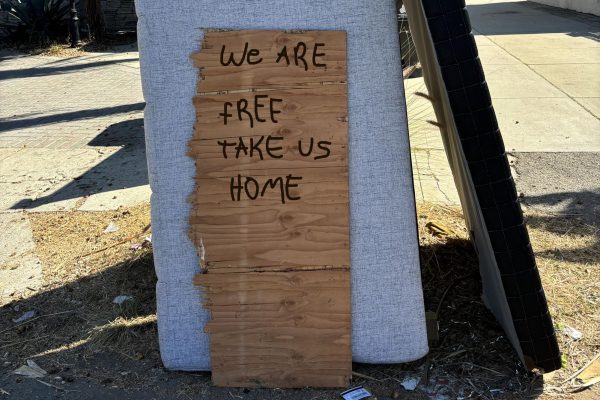‘One small gesture that goes a long way:’ The evolving topic of pronouns
Photo credit: Graphic created by Greta Irvine
The conversation around pronouns has evolved with great speed in recent years. As there is a growing visibility of the transgender community and individuals beyond the binary, the topic of pronouns has gained an increased focus in school and work environments as well as on social media.
Merriam-Webster’s Word of the Year for 2019 was they: a common word in the English language, a personal pronoun. Warranting a title administered to only words that were a top lookup during the year is no small feat. In fact, the viewership for the word they increased 313% in 2019. What caused such a sizable spike in interest?
The Merriam-Webster staff pointed to two reasons for this increase on their website: first, they had revised the definition for the term, and, secondly, the use of the nonbinary “they” was prominent in the media throughout the year.
The revised definition noted in the dictionary is as follows: they may be used to refer to a “single person whose gender identity is nonbinary.”
While this development of language is simply an extension of a definition, a research article in PNAS finds “language is meaningfully associated with the construction and maintenance of attitudes toward gender roles and categories.”
Hence, as language develops, so will societal norms.
“The culture around gender identity is rapidly evolving,” Dr. Rachel N. Levin said in reference to the increased awareness of personal pronouns such as they. Levin, the Associate Professor of Biology and Neuroscience and Dean Of Women at Pomona College, began research within the transgender community over 15 years ago studying the development of transgender identity in humans and currently teaches a course at Pomona College titled Science, Power and LGBTQ Identities.
As a society used to thinking in the binary, “there needs to be an initial education [on pronouns] and an ongoing education as-well,” Levin said. “It’s a matter of keeping your ears open.”
Background
The role of pronouns in the English language is not a new concept. “A pronoun is a word that refers to either the people talking (I or you) or someone or something that is being talked about (like she, it, them, and this),” defines the UWM LGBTQ+ Resource Centre. Put simply, pronouns are a set of words that are used in place of someone’s name.

Due to the increased visibility of nonbinary individuals, the idea of “preferred gender pronouns” came to the forefront of conversations a few years ago, suggesting individuals may prefer pronouns beyond the normalized and socially accepted she/her and he/him. Such conversation soon shifted away from “preferred” pronouns as the UC Davis LGBTQIA Resource Center writes, “[this] suggest[s] an element of flexibility or that someone’s identity is less than valid. Someone’s name and pronouns are not suggestions and are not preferred over something else. They are inherent to who we are.”
Fitness & Wellness Teacher Dani LeNoir (she/they) shares a corresponding sentiment.
“We’re all entitled to being addressed how we want to be addressed — we’re autonomous people, and we have control over, for the most part, how we present to the world and … how we feel inside,” LeNoir said. “Honoring someone’s identity is super super important. It’s one small gesture that goes a long way.”
Even with an increase of discussions surrounding pronouns, in the present-day, many individuals continue to address others in the binary using the the pronouns he/him associated with the male gender and she/her associated with the female gender, though not everyone who use the pronouns she/her identifies as a female person and not everyone who uses he/him identifies as a male person. Other pronouns, commonly existing under the terms gender-neutral or gender-inclusive pronouns, are often used by queer, gender non-conforming, nonbinary, gender fluid, transgender individuals as well as those who use other terms to describe themselves and their identity.
“At the moment we’re shunted into boxes and systems that don’t understand us. We’re all individuals who need their own approach, that can’t always be covered by a one-size-fits-all system.” Jamie Wareham (he/him), digital content producer and LGBTQ+ journalist said.
Current Conversations
As reported by Pew Research Center, recent study found one in five Americans knew someone who uses nonbinary pronouns. However, even as awareness of the spectrum of pronouns increases, LeNoir believes conversations regarding identity need to start earlier.
“My opinion or philosophy is that these conversations start at home before kids even get to the age of being at school, but not everybody feels that way with this controversial topic. We gender people before they’re even born and when we don’t give folks the space to really figure things out. They are set out for us,” LeNoir said. “In a perfect world for me, we would allow kids to have the space to really explore who they are and figure out how they want to present to the world because our identities are always shifting, all parts of our identities, not just gender.”
Freshman Remi Cannon (she/they) describes her experience learning about pronouns, acknowledging that many people do not have this early education but have begun to engage with the topic.
“In early in middle school, I was a part of an all-queer group chat and people were starting to exchange pronouns, and that’s where I started getting used to the concept of when you introduce yourself, you also include your pronouns,” Cannon said. “Throughout the years, with queer friends, I learned more about the gender spectrum, so that’s when I started to experiment with my expression and the labels I chose. [Displaying pronouns] is becoming more of a custom like in email [signatures] or social media bios and now in school Zoom profiles. It’s just something that’s has become more present in my life that I get to practice every day now even with my [cisgender and heterosexual] peers, which is really cool.”
Wareham also describes the importance of cisgender individuals engaging in conversations surrounding gender and pronouns.
“We all have a shared responsibility for creating a better world, so we should use whatever tools we have in our kits to start these conversations. Particularly for cisgender people, we should know that by talking about our pronouns we create the idea, a norm, that we shouldn’t assume people’s identity from the way they look,” Wareham wrote. “It’s not our fault we do this — our society has created and uses stereotypes every day — but it is our responsibility to change the world and the systems that create these often out-of-date views.”
Along with engaging in conversations about pronouns, the practice of asking someone’s pronouns can become normalized through the inclusion of who you ask, Levin said.
“I think the thing that we can encourage is, if you need to know someone’s pronouns … then just ask and ask cisgender people too. Normalize that so that you’re not just saying, ‘Hey, I can’t tell what you are, so what [pronouns] do you want me to use?’ Understand that there are thousands of ways of presenting using she or presenting using he so you can’t always assume,” Levin said. “And remember we really don’t need pronouns all that much, so you don’t have to ask on day one. But normalize it for everybody.”
Introducing Pronouns
Today, the use of gender-neutral pronouns remains unfamiliar to some, particularly older generations. According to the Pew Research Center, Generation Z is most familiar with gender-neutral pronouns, followed by Millennials and Generation X. To these older generations, assuming one’s pronouns based on appearance and gender expression has been a cultural norm present in society for hundreds of years, reinforcing the stereotypes that there is a certain way to look when you are a certain gender or use certain pronouns.
“It’s super important to me that we stop assuming people’s gender because gender is so fluid — there is no one way to look feminine there is no one way to look masculine, there is no one way to look nonbinary or gender queer,” LeNoir said. “So, I think it really starts with dismantling these ideas that just upon seeing you, I can assume your pronouns. We’ve got to normalize introducing ourselves in such a way and that’s why I love that we can have our pronouns in the Zoom space now.”
Along with Zoom display names, many have begun to add their pronouns to social media bios, email signatures and name tags amongst other spaces and profiles. Verbal sharing of pronouns has increased in work and school environments as well. Wareham describes the meaning of creating a safe space to share pronouns.
“It means when transgender people come out, they are less likely to face abuse, violence and prejudice for their identity – which they can’t change,” Wareham wrote. “And it means for everyone, we can live in a world that isn’t defined by stereotypes, that confine all of us, but one where we can be free to be ourselves.”
Instagram, among other platforms, recently added a feature permitting users to input their pronouns into their bios. As a platform serving many young users, this addition allows younger individuals to begin to engage with pronouns. Senior Cleo Helscher (they/them) comments on the introduction of pronouns at a young age.
“I think a lot of people make the argument of ‘Oh well, you’re so young and you might not know really how you identify’ … but I feel like there’s not really any harm if you go by pronouns that you then end up changing or you switch identities. I feel like that’s very villainized,” Helscher said. “There should be a more fluid perception of [gender] so if a kid is in sixth grade and goes by different pronouns for a bit and then switches back to their original pronouns, why not let them have that experience? Why not let them grow?”
In addition to shifting pronouns, some individuals have multiple sets of pronouns that they use. For some, these pronouns are interchangeable while for others, the pronouns they use many change from day-to-day depending on how they identify or other factors that play in.
“There’s a kind of queer guilt that comes with having two different pronouns or changing pronouns and feeling like you have to educate others on that,” Cannon, who uses two sets of pronouns, said. “And now people feel bad if they get them wrong, so I think that when someone initiates the conversation around pronouns, especially if that person is cis, it’s really validating. People in general would feel less burdened if it was a norm to introduce yourself with your pronouns.”
Americans today are split on their comfort using a gender-neutral pronouns to refer to someone, with almost half saying they would be somewhat or very uncomfortable doing so. Some of this discomfort may come from a confusion around the use of pronouns and a fear of making mistakes when referring to an individual. Levin shares her approach when making a mistake regarding an individual’s pronouns.
“In situations where a certain student returns from a break between semesters and has changed their name and pronoun usage — so if I knew someone as Nancy and now they’re James, I may mess up. And my advice is to acknowledge it and move on,” Levin said. “And then, if needed, I suggest following up if it seems appropriate and remember it’s their comfort you’re concerned about not your own … The point is to have them know that you see who they are, and that it’s your mistake.”
Pronouns in the School Environment
In recent years, many education institutions have begun to allow students to signal their pronouns to teachers at the beginning of the year. Over a decade ago, the University of Vermont became the first school in the U.S. to allow students the option to enter pronouns into campus data systems. Many colleges and universities have followed suit as tracked on the online resource Campus Pride. Levin shares her personal approach in the classroom.
“Because we’re in college, I email my class in advance and not only to tell them what books [they need] for class but also say, ‘Hey, if you think there’s any chance that your name or pronouns might be incorrectly used or you want to make sure that I use the right one on day one, please let me know. It’s important to me.’ And invariably, if there is someone to whom it applies … they often will,” Levin said. “I just want to make it clear that that is private, but it’s also a matter of respect, both to use the proper pronoun … but also to respect that people will share [their pronouns] when they want to.”
Helscher shares their experience with pronouns at a high school level, noting the value and impact of respecting pronouns on campus.
“I have a level of respect for my peers and I think that it’s something that takes so little to ask or look at someone’s pronouns [on Zoom] and then react accordingly. It makes me feel like I’m really seen as a human being,” Helscher said. “I make this comparison a lot but when there’s a dog, for example, people ask ‘Oh, is it a boy or girl?’ and then they immediately switch their pronouns based on that. And so I just feel like people warrant the same respect as a dog at least and deserve to feel affirmed and validated. And I think it’s hard for someone to really learn and feel like they have an opportunity to grow if they’re not getting respected or they don’t feel safe at their school and with their friends.”
Cannon agrees with Helscher, expanding on how to integrate such conversations into the classroom.
“If teachers have the capacity to ask someone their favorite ice cream flavor during, for example, a classroom icebreaker, you might as well ask someone’s pronouns. It can be an option to share as a lot of people aren’t comfortable with their pronouns being public, but just the option to share in the beginning of a new school year, especially when meeting new students at Archer, is really important,” Cannon said. “It opens up opportunities for students to bring this conversation to their families and communities and educate older generations as well.”
To hear to more about Cannon’s perspective on valuable actions to be taken, listen to the audio clip below.
LeNoir reflects on pronoun education at Archer and future conversations to be had.
“Right now, it’s part of our sixth grade curriculum, and we talk about it all throughout students’ experience at Archer. I would love to see those conversations expand. I feel good about some of the progress that we’ve made so far, especially with getting our pronouns on Zoom, but it doesn’t just stop there,” LeNoir said. “Obviously there’s a lot that needs to be talked about as a larger society, and we’re still very much in this very first phase of things.”
As an all-girls school, the use of female-oriented language at Archer is often present when addressing the community, such as referring to students as “ladies” or “girls.” An alternative to this is the use of gender-neutral language, which is language that does not identify a specific gender.
“Working towards more gender-neutral names for things is a way to be more inclusive,” Helscher said, and shared an example of such language in practice.
“I remember me and my friends reached out [to administration] about Galentine’s Day and they changed it to Palentine’s Day,” Helscher said. “It was something really simple, but it was really nice, and it felt like they were making that effort. Doing that on a bigger scale, I feel, would really help a lot of people.”
Dangers of Current Pronoun-Sharing Practices
Although introducing one’s pronouns in group settings has benefits, Levin shares the dangers of current practices regarding pronoun sharing.
“I was seeing an alarming increase of the singsong ‘everybody give your name and pronouns’ in the beginning of the class as a way of signaling how progressive we all are, when in fact, my students, colleagues and friends were telling me that for many of them that practice was doing more harm than good,” Levin said. “It really depends on who’s out, whether they are in the process of figuring out their identity and all other kinds of factors.”
Similarly to verbal sharing, displaying pronouns on Zoom may be challenging for some young individuals.
“Displaying pronouns on Zoom has its complications as well because some folks don’t feel safe to do so whether that be in whatever institution they’re in or even at home,” LeNoir said. “I can imagine being 13 and having some pronouns that my parents didn’t know about and for whatever reason they see my Zoom and they’re like, ‘What is this?’”
With the widening coverage of pronouns in the media, controversy has arisen on the topic regarding language rules, education and employment systems and disputes have even begun within the political sphere.
“I understand it’s a big step for society to begin this new custom but it’s not mature content. It’s an identifier,” Cannon recently said. “And so just adding, ‘Hello, my name is Remi, my favorite color is green and I go by she/they pronouns’, I think is absolutely appropriate and necessary.”

Greta Irvine joined the Oracle as a staff reporter in 2020 and became the News Editor in 2021. In 2022, she became the Editor-in-Chief. She graduated in...










Ms. Geffen • May 31, 2021 at 11:03 pm
This article is phenomenal, Greta! Thank you for sharing so much information and for including various perspectives, context from Universities and beyond, and real-life examples from within our Archer community. I appreciated the opportunity to gain a deeper understanding around pronoun use , ways to be more inclusive and respectful in and out of Archer, and the nuances of these conversations (split pronouns and more). I’m left pondering how I want to speak about gender and pronouns with my own small children.
Tiffany Smith-Anoa'i • May 23, 2021 at 8:57 pm
Greta,
Great job with this extensive article. Very well researched and thought out.
Mutual basic respect and curtesy goes a long way.
Brava!